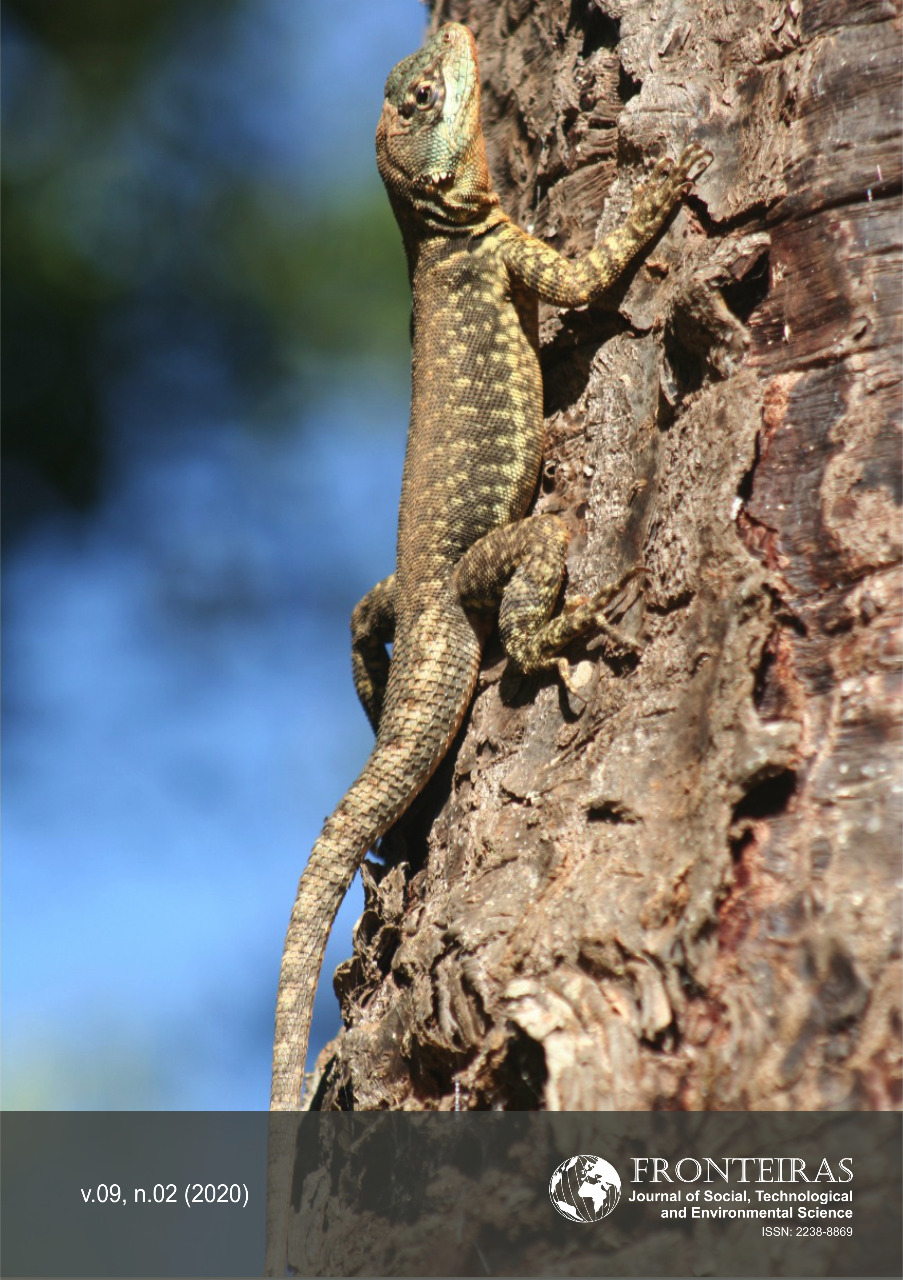What Physical Aspects Influence Biochemical Activity in Soil in a Natural Landscape?
DOI:
https://doi.org/10.21664/2238-8869.2020v9i2.p142-154Palavras-chave:
Soil Depth, Seasonality, Cerrado, Soil BiochemistryResumo
The objective of this paper was to evaluate the effect of depth, seasonality and phytophysiognomies on the biochemical activity of soils in native Cerrado biome. Additionally, we listed which chemical parameters influence the activity of the microbiota and enzymatic activity in these environments. We selected eight sampling areas of Cerradão (Forest) and four areas of Cerrado (shrub land) and evaluated the chemical characteristics and biochemical activity. The depth, sampling site and seasonality directly affected soil metabolic activity. Microbial biomass carbon was influenced by interaction between soil depth and sampling site and the enzyme activity tends to be higher in the superficial layer of the soil. The analysis of redundancy showed strong influence of environmental variables (phosphorus and CTC) on the biological activity of the soil. Thus, the metabolic activity of microorganisms is highly influenced by intrinsic soil characteristics of each sampling site.
Referências
Araújo ASF, Magalhaes LB, Santos VM, Nunes LAPL, Dias CTS. 2017a. Biological properties of disturbed and undisturbed Cerrado sensu stricto from Northeast Brazil. Braz. J. Biol. 77(1): 16-21. http://dx.doi.org/10.159/1519-6984.06715
Araújo ASF, Bezerra WM, Dos Santos VM, Nunes LA, De Lyra MD, Do Vale BFM et al. 2017b. Fungal diversity in soils across a gradient of preserved Brazilian Cerrado. J. Microbiol. 55(4): 273-279. http://dx.doi.org/10.1007/s12275-017-6350-6
Babujia LC. Bioindicadores de qualidade do solo avaliados em diferentes profundidades sob plantio direto e convencional [Dissertação]. Londrina: Universidade Estadual de Londrina; 2010.
Baldrian P, Valáskova V, Merhautová V, Gabriel J. 2005. Degradation of lignocellulose by Pleurotus ostreatus in the presence of copper, manganese lead and zinc. Res. Microbiol. 156(5-6): 670-676. http://dx.doi.org/10.1016/j.resmic.2005.03.007
Borowik A, Wyszkowska J. 2016. Soil moisture as a factor affecting the microbiological and biochemical activity of soil. Plant Soil Environ. 62: 250–255. http://dx.doi.org/10.17221/158/2016-PSE
Clima-Date. Dados climáticos para cidades mundiais. [cited 2018 jul. 01]. Available from: https://pt.climate -data.org.
Dick G, Schumacher MV. 2015. Relações entre solo e fitofisionomias em florestas naturais. Ecol. Nutr. Florestal 3(2): 31-39. http://dx.doi.org/10.5902/2316980X16741
Empresa Brasileira de Pesquisa Agropecuária - Embrapa. Manual de método de análise de solo. 2. ed. Brasília: Embrapa Solos; 2011.
Ferreira AS, Camargo FAO, Vidor C. 1999. Utilização de micro-ondas na avaliação da biomassa microbiana do solo. Braz. J. Soil Sci. 23: 991-996. http://dx.doi.org/10.1590/S0100-06831999000400026
Giacometti G, Demyan MS, Cavani L, Marzadori C, Ciavatta C, Kandeler E. 2013. Chemical and microbiological soil quality indicators and their potential to differentiate fertilization regimes in temperate agroecosystems. Appl. Soil Ecol. 64: 32–48. http://dx.doi.org/10.1016/j.apsoil.2012.10.002
International Plant Nutrition Institute – IPNI. Manual Internacional de Fertilidade do Solo. 2. ed. Piracicaba: Pofatos; 1998.
Kivlin SN, Treseder KK. 2014. Soil extracellular enzyme activities correspond with abiotic factors more than fungal community composition, Biogeochemical 117: 23–37. http://dx.doi.org/10.1007/s10533-013-9852-2
Lacerda KAP, Cordeiro MAS, Verginassi A, Salgado FHM, Paulino HB, Carneiro MAC. 2013. Organic carbon, biomass and microbial activity in an Oxisol under different management systems. Rev. Ciênc. Agrárias 56:249-254. http://dx.doi.org/10.4322/rca.2013.036
Margalef O, Sardans J, Fernández-Martínez M, Molowny-Horas R, Janssens IA, Ciais P et al. 2017. Global patterns of phosphatase activity in natural soils. Sci. Rep. 7: 1337-1349. http://dx.doi.org/10.1038/s41598-017-01418-8
Mendes IC, Sousa DMG, Reis Junior FB. 2015. Bioindicadores de qualidade de solo: dos laboratórios de pesquisa para o campo. Cadernos Ciênc.Tecnol. 32(2): 185-203. [cited 2018 abr. 8] Available from: https://seer.sct.embrapa.br/index.php/cct/article/view/23311
Neal AL, Rossmann M, Brearley C, Akkari E, Guyomar C, Clark IM et al. 2017. Land-use influences phosphatase gene microdiversity in soils. Environ. Microbiol. 19: 2740–2753. http://dx.doi.org/10.1111/1462-2920.13778
Nogueira MA, Albino UB, Brandão-Júnior O, Braun G, Cruz MF, Dias BA et al. 2006. Promising indicators for assessment of agroecosystems alteration among natural, reforested and agricultural land use in southern Brazil. Agri. Ecosys. Environ. 115: 237–247. http://dx.doi.org/10.1016/j.agee.2006.01.008
R Core Team, R. 2017. A language and environment for statistical computing. R Foundatiton for Statistical Computing. Vienna. [cited 10 ab. 2018]. Available from: https://www.R-project.org/. 2017
O’Hara RB, Kotze DJ. 2010. Do not log-transform count data. Methods in Ecology and Evolution 1:118-122. http://dx.doi.org/10.1111/j.2041-210X.2010.00021.x
Saidi D. 2012. Importance and role of cation exchange capacity on the physicals properties of the Cheliff saline soils (Algeria). Proc. Eng. 33: 435–449. http://dx.doi.org/10.1016/j.proeng.2012.01.1223
Sano EE, Rosa R, Brito JLS, Ferreira LG. 2010. Land cover mapping of the tropical savanna region in Brazil. Environ. Monit. Assess. 166: 113-124. http://dx.doi.org/10.1007/s10661-009-0988-4
Sano SM, Almeida SP, Ribeiro JF. Cerrado ecologia e flora. Brasília: Embrapa Cerrados; 2008.
Silva GVC. 2016. Respiração do solo em uma área revegetada de Cerrado, em Cuiabá-MT. Ciênc. Nat. 38(1): 434-442. [cited 2018 jul. 03]. Available from: http://redalyc.org/articulo.oa?id=467546196040
Skorupa ALA, Guilherme LRG, Curi N, Silva CPC, Scolforo JRS, Marques JJGSM. 2012. Propriedades de solos sob vegetação nativa em Minas Gerais: distribuição por fitofisionomia, hidrografia e variabilidade espacial. Rev. Bras. Ciênc. Solo 36(1): 11-22. http://dx.doi.org/10.1590/S0100-06832012000100002
Vezzani FM. 2015. Solos e serviços ecossistêmicos. Rev. Bras. Geogr. Fís. 8(4): 673-684. [cited 2018 jul. 03]. Available from: https://periodicos.ufpe.br/revistas/rbgfe/article/view/233637
Zago LMS, Oliveira RN, Bombonatto AKG, Moreira LMO, Melo ENP, Caramori SS. 2016. Extracellular enzymes from Cerrado soils as quality bioindicators in agricultural areas in Goiás, Brazil. Fronteiras: J. Soc. Technol. Environ. Sci. 5(1): 104-127. http://dx.doi.org/1021664/2238-8869.2016v5i1.p104-127
Zago LMS, Sousa VR, Caramori SS. 2017. Biochemical indicators as parameters of changes in the fertility of Brasilian Cerrado soils. Int. J. Curr. Res. 9(5): 50979-50985.
Zago LMS, Moreira AKO, Silva-Neto CM, Nabout JC, Ferreira ME, Caramori SS. 2018. Biochemical activity in Brazilian Cerrado soils is differentially affected by perennial and annual crops. Aus. J. Crop Sci. 12(2): 235-242. http://dx.doi.org/10.21475/ajcs.18.12.02.pne716
Downloads
Publicado
Como Citar
Edição
Seção
Licença
Esta revista oferece acesso livre imediato ao seu conteúdo, seguindo o princípio de que disponibilizar gratuitamente o conhecimento científico ao público proporciona maior democratização mundial do conhecimento.
A partir da publicação realizada na revista os autores possuem copyright e direitos de publicação de seus artigos sem restrições.
A Revista Fronteiras: Journal of Social, Technological and Environmental Science segue os preceitos legais da licença Creative Commons - Atribuição-NãoComercial 4.0 Internacional.


